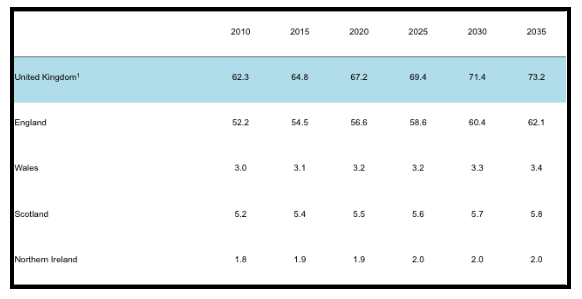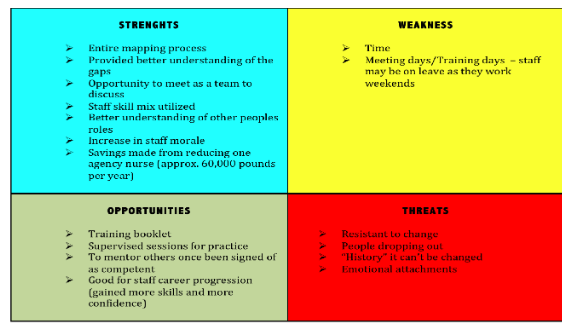Optimizing Patient Care: The Crucial Role of District Nurses in a Primary Healthcare Setting
Introduction
The function of district-nurses remains essential within primary-health-care-team setting and comprises of them making routine visits to residences of patients to deliver support and care to family members and patients through their expert advices and timely medical aid and support (District nurse, 2020). They also provide direct-care to patients exhibiting a teaching role as well as a supporting role in the process to help patients develop an independent confident attitude caring for themselves, and minimising their reliance on caregivers. District nurses keep hospital reliability, readmissions and admissions of patients to the minimum in the process, which highlights the importance of healthcare dissertation help in understanding their impact on patient outcomes.
According to the ONS (2019), in the present scenario at UK, there has been huge pressure on the procurement of quality and experienced nursing services due to the high number of aged population in the nation demanding hospital care and medical services round the clock, which is leading to an increased staffing demand of qualified district nurses. Professional-skills-mix of a district-nurse relates to the experience and skills, academic-knowledge, CPD (continuous-professional-development) and how they utilize the same judiciously to deliver efficient professional judgement and practice (Jacob, et al., 2015).

The present essay aims on the development of professional insights of district nurses, as an introspection to self for delve into self observation, discernment, deduction and perception through noesis for the ultimate aim of improving patient experience via judicious implementation of skills mix.
Background
The increased age range of individuals to live longer leads to occurrence of complex health problems like - long-term co-morbid diseases, disability, dementia or cognitive disorders, immobility, frailty and terminal illness (NHS 5 Year Forward, 2017). There is an increased number of acute-care patients who due to high demand on NHS's health services, are discharged at an earlier date from hospital settings, and they rely heavily on the district nurses visiting their residences to provide experienced residential care to make a 360 degree recovery adding years to their life by staying independent, healthy and away from readmissions. The scenario is depicted in the following figures:



Skills Mix of district nurses in association with patient-outcome
According to "Francis-Inquiry-Report" of 2013, strong recommendation was provided for improvement of skills-mix and staffing-level of the district nurses (The Kings Fund, 2013). As opined by the internationally acclaimed patient-safety expert, Prof. Don Berwick, it is crucial to provide emphasis on NHS staffs for developing life-long-learning-ethical practices, staying ahead of the crew by getting in depth knowledge on - latest practices of quality control, quality improvement and planning (Department of Health and Social Care, 2013).
Furthermore the report by NHS England, Medical-Director, Sir-Bruce-Keogh of 2013, identified major reasons behind failure and increase in patient mortality rates, as inadequacy in staff; after review of 14 trusts, recommending replacement of staff services with agency (Keogh, 2013). Also the NPSA (National-Patient-Safety-Agency) according to RCN guidance (on nurse staffing and safety) recorded 30,000 and more incidents relating to patient-safety, resulted from inadequacy in staffs which undermined patient-safety in majority of cases (RCN, 2010). Studies have been presented in Table 1 below, regarding the district-nurse skills-mix associated with that of patient-outcome.
Take a deeper dive into Analysis of Patient Harm and Inefficiency in Liverpool Community with our additional resources.
Studies representing association between nursing-skills and patient-outcomes in previous years

In the underlying sections, on the basis of the aforementioned scenario the present essay focuses on aim of implementing effective skills-mix within teams of district nurses for improvement of patient outcome through gap analysis and change implementation addressing the same.
Gap analysis in relation to present case-study
In the present scenario the process of gap-analysis has been considered comparing the present performance based scenario of district nurses with the desired results by identifying missing structures, or strategies, procedures, capabilities, techniques, practices or skills, to finally follow through by recommendations which will help in meeting the study goals of better patient outcome delivery (Beauvais, et al., 2017). The fishbone diagram provided below, addresses the gap in the provision of services by district nurses at UK.

From the diagram the significant gaps addressed in the process of good patient-outcome delivery are those of: work duplication resulting in time wastage ; improper and incomplete utilization of human resources regarding the permanent nursing staffs; low morale hindering work progress of staffs and frustrations arising from the already complex work; poor feedback management and untimely or missed patient feedbacks obtained during the process; increased waiting time for patients leading to patient discomfort and health disparity. Hence changes must be planned according to these arenas in order to improve patient experience from the process.
Case-Scenario
In order to do identify gaps, address changes necessary and implement changes within the nursing team effectively, the present case scenario must be addressed. Provided below is a representation of a typical case-failure regarding the job of telephonic call-outs to nursing practitioners for addressing a patient issue, i.e. blocked catheter of patient.

The situation describes how a simple issue of changing blocked catheter tube of patients can remain unresolved, hampering patient health and adding in to patient discomfort over hours due to lacking competency and expertise of nursing practitioners. The registered nurse fails in assessing patient health status quos and in flushing off the blockages within catheter, sending the patient off to A&E nurses in emergency department, causing the case to hence remain unresolved in the team or community of health-care providers. On the other hand, if the case had been taken up by a competent Registered Nurse, then the nurse with their necessary skills-mix and experience would have resolved the issue within a short time span, leading to satisfied patients and uncompromised health-outcomes.
Change Planning- as per case study scenario
Change-management in nursing demands the follow-up of effective change-management strategies involving several sequential steps namely- assessment of staff and organizational readiness towards the change; development of impact-assessment from change; creating chance-communication-plan to communicate effectively with staffs at multiple level; management of change-resistance and change-barriers efficiently; identifying stakeholders involved and management of the same; development of a staff-training-plan.
In accordance to the present case-scenario, mapping has been done for identifying staff-competency level within the practitioner team of nurses, via the use of color-codes following the colors of traffic-light i.e. red signifying zero competency or non-competency, yellow signifying 50% competency of staffs and green signifying 100% or full-competency in regards to the district nurses within the nursing-team. The result of the color-coded mapping of staff-skills is depicted below:

The results or outcomes of the color-mapping process showcased that the Bands 7 and 6, comprised of competent district nurses capable of performing all the necessary jobs (26 in number) of a nursing practitioner efficiently exuberating skills and confidence hence marked with green color coding. The band 5 comprised of 73% competent nurses wherein major tasks could be effectively conducted out of the 26 with 7 tasks not being properly achieved by the nurses. This was marked in yellow color coding as a representation of competency. The other bands were marked red due to lower competency level but the approach to addressing change and implementing has considered to focus on transforming the yellow coded staffs to green and then later focus on transforming the red coded staffs to yellow followed by green, to enhance the number of competent nurses available for serving the patients.
Change Implementation
Change process management and its proper implementation requires continuity of practices harboring change and routine follow-up with enhancement in communication amongst participating members. As per the present scenario demands, the implementation steps which were considered were namely - team-meeting organized on weekly basis, provision of clinical-supervision to junior and fresher nurses; on-site training provided to junior-nurses; competency-booklet to be maintained; troubleshooting practices to be incorporated; conducting 1 to 1 session to solve issues or develop lacking skills; obtaining patient feedback and reviewing the same.
Transformational-Leadership-Style
The transformational style of leadership is essential in clinical practices concerning the proper uptake and development of graduate-nurse skills. Through transformational-leadership, a healthy work environment is promoted for staffs and employees leading to enhanced staff-satisfaction, patient satisfaction and retention (Hutchinson, and Jackson, 2013). Thus in the present case study to suit the needs and address the skills development of graduate nurses transformational-leadership was undertaken. This not only helped to inspire the nurses within team towards enacting changes to - their expectations, motivation and perception of work focusing to a common objective; but also aided in challenging the previous existent status-quo, encouraging and developing creative-thinking within them. Furthermore, it helped in delivering one to one encouragement and support to individual staffs, offering open-channels of communication within team of nurses, and the transformational leader.
Psychometric-profiling
Furthermore to implement changes efficiently, Psychometric-profiling as a tool was applied. Meredith-Belbin's tool for identifying team-roles of individual staffs on basis of their weaknesses and strengths was utilized to determine their job-roles and then relaying the responsibilities lying with that role (Source: www.Belbin.com, 2019). Psychometric-Profiling also aided in developing team-members to grow self-awareness and a ready insight related to their self-weakness or strengths existing and how to engage towards developing the weaknesses transforming them to strengths (Rasmussen, 2019). Also in the implementation process, Observer Assessment as a tool and SPI or Self-Perception-Inventory had been used for acquiring detailed feedback on staffs. The Psychometric-Profiling-Tool also helped registered nurses in understanding their unique team-roles, developing team,-relationship amongst other members. District nurses through the same, understood with greater clarity on what needs to be rectified, what needs to be developed on basis of what is expected from them.
Change-Management-Model - Kotter
Implementation of change comprises transfer of significant recommendations onto staff behavior for aiding their development process and planning of the implementation strategy needs to be conducted prior to process of development. The Kotter's model has been considered suitable in regards to present scenario for bringing several change-mechanisms to the service-delivery process as necessary (Mount, and Anderson, 2015). The stages to be followed during the Kotter's change-management-process has been demonstrated via the figure below:

Pre-Change and Post-Change Scenario
Several improvements were recorded after the change-monitoring and systematic change-implementation-procedure as depicted in the Table-2 below.

Conclusion
From the entire study, it can be concluded that the outcomes which can be expected from change-planning, strategic planning and implementation of proposed case-plan are namely: enhanced patient care will be achieved with enhanced skill-mix and staff competency; safer-care delivered; reduction in patient-waiting-time and expenditure for the NHS-Trust and highly-improved patient-experience.

However implications do exist for the study. The insufficiency of evidence from UK; necessity of more studies reflecting Health-care-assistant and Nurse-Associate contributions, or positive outcomes are some future implications of the study. Furthermore, SR should also be conducted for analyzing how improved skill-mix of staffs lead to improved patient-outcome. The NHS authority must also be informed on the lacking economic-evidences related to improper staffing as well as primary-care based lacking skill-mix of nursing practitioners, at UK.
References
Beauvais, A.M., Kazer, M.W., Aronson, B., Conlon, S.E., Forte, P., Fries, K.S., Hahn, J.M., Hullstrung, R., Levvis, M., McCauley, P. and Morgan, P.P., 2017. After the gap analysis: Education and practice changes to prepare nurses of the future. Nursing Education Perspectives, 38(5), pp.250-254.
Hutchinson, M. and Jackson, D., 2013. Transformational leadership in nursing: towards a more critical interpretation. Nursing inquiry, 20(1), pp.11-22.
Jacob, E.R., McKenna, L. and D'Amore, A., 2015. The changing skill mix in nursing: considerations for and against different levels of nurse. Journal of Nursing Management, 23(4), pp.421-426.
Mount, A. and Anderson, I., 2015. Driving change—not just a walk in the park: the role of the nurse champion in sustained change. Nurse Leader, 13(4), pp.36-38.
Rasmussen, S., 2019. The use of psychometric profiling in team coaching. In The Practitioner’s Handbook of Team Coaching (pp. 506-514). Routledge.
Appendix
SWOT Analysis of change-implementation-process for developing staff skills-mix

What Makes Us Unique
- 24/7 Customer Support
- 100% Customer Satisfaction
- No Privacy Violation
- Quick Services
- Subject Experts



